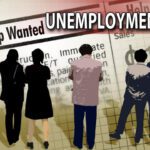By John Kennedy
The News Service of Florida
Florida’s unemployment rate has hit 12.2 percent, the highest level since records first began being kept 40 years ago, the Agency for Workforce Innovation reported Friday.
 The February jobless numbers grew .2 percent from the previous month’s figures, with Florida now distancing itself further from the national unemployment level of 9.7 percent, which has been generally holding steady.
The February jobless numbers grew .2 percent from the previous month’s figures, with Florida now distancing itself further from the national unemployment level of 9.7 percent, which has been generally holding steady.
Some analysts, though, found some silver lining in the darkening jobless picture.
“While the unemployment rate is a lagging indicator of economic recovery,” said Cynthia Lorenzo, AWI director, “last month’s positive job growth of 26,300 jobs and a 300 percent reduction in the number of layoff notices since the peak last May are both encouraging signs.”
But with 1.1 million Floridians out-of-work, the state’s economy remains clearly punishing. The 12.2 percent unemployment is up 3 percentage points from last February, as 211,500 Florida jobs disappeared in that time.
The state’s hardest-hit areas are Flagler County (17 percent unemployed), Hardee County (15.6 percent) and Marion County (15.4 percent), the agency reported. Lowest jobless counties were Liberty County, with 7.5 percent out-of-work, Monroe (8 percent) and Leon (8.6 percent). Fifty-five counties were struggling with double-digit unemployment, compared to 58 counties in January, AWI found.
Following a familiar theme of the recession, Florida’s construction industry has lost the most jobs over the past year – with 73,600 jobs gone, or more than 17 percent of the building trade’s workforce. Health care and private education remain the only job sectors showing any signs of gaining employment, AWI reported.
Every metro area in Florida has lost employment over the past year – except for the Panama City area, where 200 jobs have been added.
Like Lorenzo, though, Sean Snaith , a University of Central Florida economist, said some of the AWI data suggests there are glimmers of an economic bounce-back.
“Unemployment is up, but so are payroll jobs,” Snaith said. “This conflicting data is an indication that we are getting close to, if not at a turning point in Florida’s labor market. The industries that we see gaining jobs are temporary employment agencies, which are typically a precursor for broader job growth across the state.”
The state’s Economic and Demographic Research Office recently forecast a peak unemployment rate of 12.3 percent – a level expected to be reached by summer and hover into the fall. But EDR also last year predicted that the ranks of Florida’s unemployed would not top 11 percent of the workforce, with a turnaround expected to begin this year.
Like that earlier forecast, the 12.2 percent unemployment standard looks likely to threaten the latest peak prediction. Indeed, Florida’s February figure exceeds any modern levels recorded during the state’s previous worst patch, the 1973-1975 recession.
The latest figures come just a day after the Florida Senate approved a jobs bill package powered by business and industry tax breaks and incentives that cost $187 million over three years. The House has been promoting a more modest approach toward urging businesses to hire.
The unprecedented unemployment level also continues to have a political component, with U.S. Senate candidate Marco Rubio quick to tie it to Gov. Charlie Crist and his support for President Obama’s federal stimulus spending, that is again being used to help balance Florida’s budget.
“Today’s report is just the latest indication that the Crist-Obama stimulus has failed Floridians,” Rubio said.


